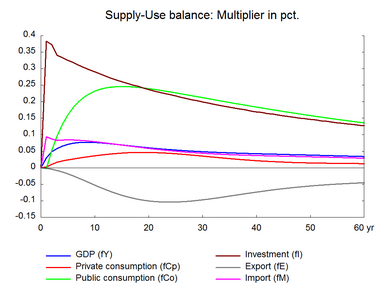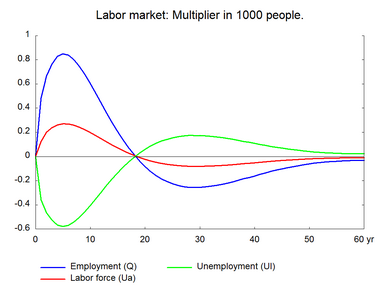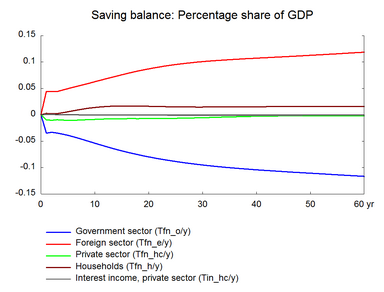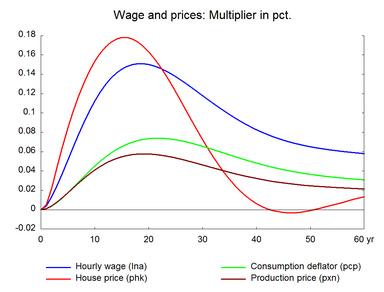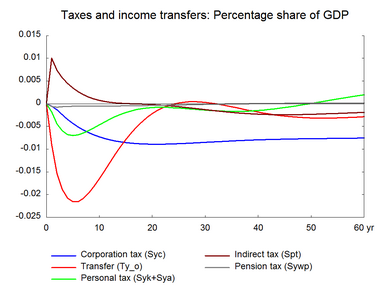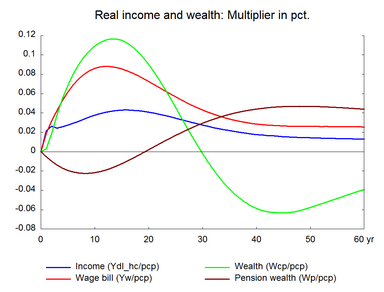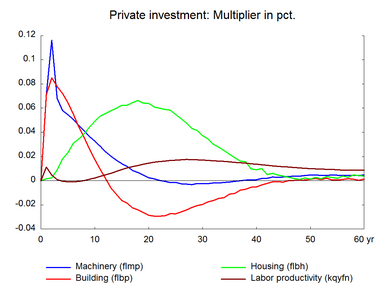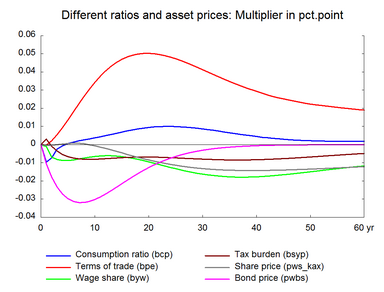Instead of investment in buildings, public investments in machinery can be increased to boost economic activity similarly. The short term expansionary effect is smaller in the present case due to the high import content of machinery investments. Table 4 presents the effect of a permanent increase in general government investment in machinery. Government investment in machinery is increased by 1000 million kroner in 2000 prices, which corresponds to about 5 per cent of the baseline in the first year. (See experiment)
Table 4. The effect of a permanent increase in public investment in machinery
| 1. yr | 2. yr | 3. yr | 4. yr | 5. yr | 10. yr | 15. yr | 20. yr | 25. yr | 30. yr | ||
| Million 2005-kr. | |||||||||||
| Priv. consumption | fCp | 18 | 80 | 135 | 169 | 197 | 322 | 426 | 478 | 472 | 423 |
| Pub. consumption | fCo | -11 | 198 | 371 | 515 | 635 | 990 | 1131 | 1186 | 1209 | 1219 |
| Investment | fI | 1136 | 1139 | 1066 | 1060 | 1056 | 1023 | 990 | 970 | 961 | 947 |
| Export | fE | -12 | -34 | -65 | -104 | -150 | -457 | -776 | -1005 | -1115 | -1123 |
| Import | fM | 709 | 680 | 663 | 683 | 698 | 707 | 663 | 607 | 563 | 530 |
| GDP | fY | 428 | 712 | 866 | 992 | 1087 | 1263 | 1224 | 1152 | 1100 | 1075 |
| 1000 Persons | |||||||||||
| Employment | Q | 0.48 | 0.67 | 0.76 | 0.83 | 0.85 | 0.60 | 0.20 | -0.08 | -0.23 | -0.26 |
| Unemployment | Ul | -0.36 | -0.47 | -0.53 | -0.57 | -0.58 | -0.41 | -0.13 | 0.06 | 0.15 | 0.17 |
| Percent of GDP | |||||||||||
| Pub. budget balance | Tfn_o/Y | -0.03 | -0.03 | -0.03 | -0.04 | -0.04 | -0.05 | -0.07 | -0.08 | -0.09 | -0.10 |
| Priv. saving surplus | Tfn_hc/Y | -0.01 | -0.01 | -0.01 | -0.01 | -0.01 | -0.01 | -0.01 | -0.01 | -0.01 | -0.01 |
| Balance of payments | Enl/Y | -0.04 | -0.04 | -0.04 | -0.05 | -0.05 | -0.06 | -0.08 | -0.09 | -0.10 | -0.10 |
| Foreign receivables | Wnnb_e/Y | -0.04 | -0.08 | -0.12 | -0.16 | -0.20 | -0.43 | -0.69 | -0.96 | -1.23 | -1.49 |
| Bond debt | Wbd_os_z/Y | 0.02 | 0.04 | 0.07 | 0.09 | 0.12 | 0.29 | 0.51 | 0.75 | 0.99 | 1.23 |
| Percent | |||||||||||
| Capital intensity | fKn/fX | -0.01 | 0.00 | 0.01 | 0.02 | 0.02 | 0.05 | 0.06 | 0.07 | 0.07 | 0.07 |
| Labour intensity | hq/fX | -0.01 | -0.02 | -0.02 | -0.02 | -0.02 | -0.03 | -0.03 | -0.03 | -0.03 | -0.03 |
| User cost | uim | 0.16 | 0.29 | 0.40 | 0.48 | 0.55 | 0.73 | 0.76 | 0.74 | 0.70 | 0.65 |
| Wage | lna | 0.00 | 0.01 | 0.03 | 0.04 | 0.05 | 0.11 | 0.15 | 0.15 | 0.14 | 0.12 |
| Consumption price | pcp | 0.00 | 0.00 | 0.01 | 0.01 | 0.02 | 0.05 | 0.07 | 0.07 | 0.07 | 0.07 |
| Terms of trade | bpe | 0.00 | 0.00 | 0.01 | 0.01 | 0.01 | 0.03 | 0.04 | 0.05 | 0.04 | 0.04 |
| Percentage-point | |||||||||||
| Consumption ratio | bcp | -0.01 | -0.01 | 0.00 | 0.00 | 0.00 | 0.00 | 0.01 | 0.01 | 0.01 | 0.01 |
| Wage ratio | byw | 0.00 | -0.01 | -0.01 | -0.01 | -0.01 | -0.01 | -0.01 | -0.01 | -0.01 | -0.02 |
Like investments in buildings, machinery investments have expansionary effects on the economy in the short run. Investment in machinery increases demand in the short run, which translates into higher production and employment. The lower unemployment will increase wage growth and reduce competitiveness. As competitiveness falls, exports fall and imports rise. Over time, the competitiveness advantage will be lost and unemployment returns to equilibrium. The expansionary effect of machinery investments is smaller because the import content of machinery investments is higher that of building investments. The smaller effect on domestic activity effect implies that the pressure on wages and prices is smaller. And the resulting real wage effect on consumption is also lower.
It is also worth noting that the impact on total investment is smaller when investing in machines than when investing in buildings. This is because the accelerator impact is smaller. Machines are used for a shorter time period and the ratio between the stock of machinery and investment is smaller.
Note that the smaller impact on domestic production and income implies stronger deterioration of public budget than when public building investments or the public purchase of goods and services increase. It should also be noted that the modest accompanying increase in government consumption reflects that the higher government stock of capital triggers an increase in depreciation, which is part of government consumption.
The four demand experiments discussed so far have similar effect on the domestic economy. They differ in terms of the magnitude of the impact on economic activity. An increase in government employment has the largest impact on the domestic economy as it has no direct link to imports. An increase in government investment in machinery has the smallest impact on the domestic economy as the import content of machinery investments is high. Similarly, the impact on government budget is the highest in the former and the smallest in the latter.
All the experiments are considered without funding and the public budget balance deteriorates permanently. The public expenditure can be financed by reducing other public expenditures or by increasing revenues. Section 18 below demonstrates financing the public purchase of goods and services by raising income taxes. If income taxes are raised to finance public expenditures there will be no positive effect on private consumption as real disposable income permanently falls and competitiveness will not necessarily deteriorate, see experiment 18 for more.
Figure 4. The effect of a permanent increase in public investment in machinery
